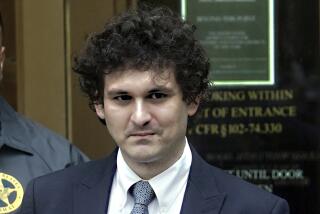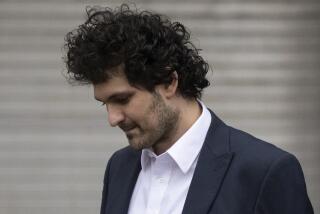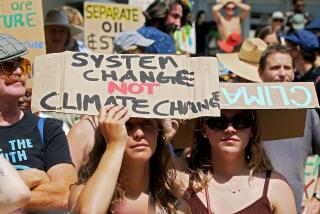Execs off the hook at S
You may have heard last week about a couple of big lawsuits brought by federal and state governments, alleging that the credit rating agency Standard & Poorâs concocted a fraudulent scheme that contributed to trillions of dollars in investment losses and the cratering of pretty much the entire world financial system.
Those are serious charges, and the federal governmentâs demand for $5 billion in penalties isnât peanuts. Yet thereâs something bloodless about the lawsuits, for the simple reason that they donât point the finger at any particular person who was responsible for these dastardly doings.
For example, you wonât find the name Harold McGraw III anywhere in the court papers. Who?
McGraw was chairman, chief executive and president of McGraw-Hill, S&P;âs parent company, in the period at issue, 2004 to 2007. (Heâs still in place today.) Did he profit from S&P;âs wrongdoing? Letâs assume so: he not only owns 10 million company shares but received $44.5 million in compensation over those years, according to corporate disclosures. Did he know or care about what was happening at S&P;? One would hope so because it was by far the most profitable domain in his empire, contributing an average of more than 70% of McGraw-Hillâs operating profit.
Harold McGrawâs largest business unit engaged in an âegregiousâ fraud that âgoes to the very heartâ of the financial crisis, Atty. Gen. Eric H. Holder Jr. said. But prosecutors have made no effort to hold him, or anyone else, directly responsible for what was done at S&P.;
These new lawsuits replay the only story uglier than the financial meltdown itself, which is the governmentâs pathetic record at prosecuting the crimes that produced it.
For companies canât do things like manipulate numbers on spreadsheets, lie about their âindependentâ judgment, and fire employees who try to rectify such errors. Only people can.
In accordance with the governmentâs standard approach to financial crisis justice, no flesh-and-blood people are on the hook in these cases. Only companies, which (moreâs the pity) canât be put in jail for their wrongdoing. Yet itâs only people who can profit from such conniving.
The lawsuits name a few executives here and there, and identify others by initials (presumably theyâre the ones who cooperated with regulators). But the overall impression is that something happened at S&P;, and some individuals were involved, but they were all swept up in some inchoate historical event that requires, nevertheless, that S&P; fork over $5 billion. Thatâs what makes reading these legal papers resemble getting through all of âWar and Peaceâ without ever meeting Napoleon.
âWeâve had the greatest explosion of elite white collar crime in history and the weakest criminal justice response,â observes William K. Black, who helped put financial wrongdoers behind bars as a thrift regulator after the savings-and-loan collapse of the 1980s. âThereâs reason to believe theyâre not unrelated.â
To be fair, the S&P; lawsuits â they include the federal case filed in Los Angeles and actions by more than a dozen states, including California â amount to a more aggressive regulatory attack than any mounted thus far. Their target is an indisputably major player in the meltdown.
The $5-billion penalty sought by the U.S. Justice Department would be a pittance compared with the damage done to investors and the general economy by S&P.; But as the equivalent of about six years of corporate profits, it would be enough to reduce McGraw-Hillâs Manhattan headquarters to a smoking hole in the ground â if you think thereâs any chance the government can make the claim stick. California Atty. Gen. Kamala Harris seeks redress of at least $1.4 billion in investment losses incurred by the California Public Employeesâ Retirement System and other state agencies on S&P-rated; securities.
The essence of the governmentsâ fraud claim is that S&P; held itself out to be an independent and objective appraiser of investment securities, especially the residential mortgage-backed bonds that were hot investment vehicles during the housing bubble. But it wasnât.
To a great extent, the investors who took S&P; at its word knew they were acting on faith. The firm, like the other major credit agencies, Moodyâs and Fitch, were paid for their ratings by the investment banks issuing the securities, a flagrant conflict of interest. S&P; charged the bankers up to $750,000 to rate really oddball paper.
The lawsuits allege that as early as 2004, S&P; began tailoring its ratings to keep those clients happy by exaggerating the safety of their securities. S&P; allegedly allowed issuing bankers to browbeat analysts for better ratings. The firm delayed or suppressed changes in its analytical software that would reveal that huge swaths of the high-rated deals were heading south. It cheaped out on hiring enough analysts to keep up with the mounting need for accurate updates. Analysts emailed each other with complaints about the corrupting of their objectivity, while executives signaled, essentially, that they should put a sock in it.
Nevertheless, McGraw-Hillâs annual reports every year from 2004 through 2007 touted S&P;âs stature as a âprovider of independent credit ratings,â even though it was then allegedly tailoring its procedures for the issuersâ benefit.
When the firm could no longer delay the inevitable, it downgraded hundreds of billions of dollars worth of mortgage securities in a torrent â 9,000 in the second half of 2007, an additional 6,300 in early 2008, including some deals it had graced with AAA ratings only a few months before. Many investors were bound by law to rely on these ratings in choosing securities for their portfolios. The flood of downgrades made a bad market much, much worse.
None of this is news. The role of the rating agencies in the meltdown was documented thoroughly by the Financial Crisis Inquiry Commission, headed by former California Treasurer Phil Angelides, in January 2011 and by a Senate subcommittee under Sen. Carl Levin (D-Mich.) a few months later. Any aficionado of our financial train wreck can repeat many of the emails cited in the lawsuit from memory.
S&P;âs response to the lawsuits is standard: The firm wasnât cooking its numbers but was relying on âthe same ... mortgage data available to the rest of the market,â it said last week. Yet S&P; held itself out to be experts â if all it was doing was repeating what everybody else knew, than who needed its opinion? Any investment bank could have dragged any nimrods off the street and gotten an opinion for âIâd wager âa lot less than $750,000.
No one should doubt that the federal and state prosecutors poured their souls into these cases. The California lawsuit followed nearly two years of investigation, interrogation and compiling of documents. And there are hints that investigations of Moodyâs may be continuing.
But the key question sidestepped by the new lawsuits is why no individuals are being brought to book for what were, in every way, the plots and designs of individual people, acting to slake their own greed and ambition. This is another example of what UC Irvine criminologist Henry Pontell calls âthe trivialization of criminal fraud.â
âThis is essentially a criminal fraud case,â Pontell told me. âThe only difference between civil and criminal cases is that they [the prosecutors] can spend a lot less on civil cases because the burden of proof is lower.â
That speaks to the impoverishment of our white collar prosecutorial corps since 9/11, when the best and brightest were diverted to anti-terrorism cases and not replaced. By normalizing major corporate fraud cases as merely matters for civil fines, however, this trend has destroyed the deterrent effect of the justice system.
âPersuasive anecdotal evidence exists that the prospect of criminal penalties is an effective deterrentâ to wrongdoing in the corporate suite, Pontell said. âUpper-class businesspersons fear shame and fear incarceration. Paying fines? No problem â thatâs a cost of doing business. If anything, itâs anti-deterrence.â
Thatâs true. Itâs a good bet that after fighting the government to a draw, McGraw-Hill will settle these lawsuits for much less than $5 billion and S&P; will retain its plausible deniability in the next meltdown. The deterrent effect will be zero.
What would really deter wrongdoing? It would be an outcome that prompts a CEO of the future to instruct his underlings: âYou better be on the straight and narrow, because the last thing in the world I want is to end up in jail like Harold McGraw.â
That might work.
Michael Hiltzikâs column appears Sundays and Wednesdays. Reach him at [email protected], read past columns at latimes.com/hiltzik, check out facebook.com/hiltzik and follow @latimeshiltzik on Twitter.
More to Read
Inside the business of entertainment
The Wide Shot brings you news, analysis and insights on everything from streaming wars to production â and what it all means for the future.
You may occasionally receive promotional content from the Los Angeles Times.











